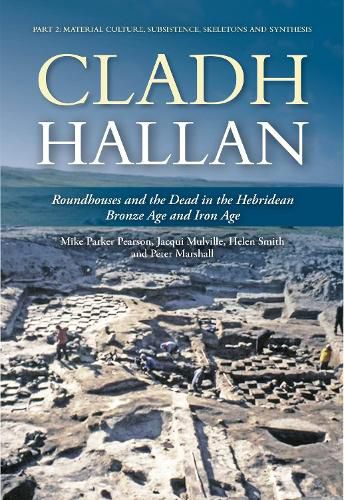Readings Newsletter
Become a Readings Member to make your shopping experience even easier.
Sign in or sign up for free!
You’re not far away from qualifying for FREE standard shipping within Australia
You’ve qualified for FREE standard shipping within Australia
The cart is loading…






This second of two volumes presents archaeological and scientific studies of a wide range of materials from the unusually long-occupied Bronze Age and Iron Age site of Cladh Hallan on South Uist in the Western Isles of Scotland. These include metalworking debris, copper-alloy, gold and iron artifacts, bone and antler tools and ornaments, flint and quartz tools, coarse stone tools, pumice, shale ornaments and fuel ash slag. The metalworking assemblage, from casting weapons, tools and ornaments, is exceptional in its size and in its being stratified within a domestic context of production. Metal tools and ornaments, some placed as special deposits on house floors, include a gold-plated penannular ring and an iron object stratified within an 11th-century BC house floor, among the earliest finds of iron artefacts in Britain. The enormous and well-preserved environmental assemblage includes faunal remains of land mammals, whales, fish, birds and marine and terrestrial molluscs. Sheep were the most numerous domestic species within an assemblage of over 150,000 land mammalian remains, and Cladh Hallan has the largest collection of canine remains for any settlement in British later prehistory. Carbonized plant remains derive principally from cultivation of barley and associated weeds of cultivation. The site's assemblage provides extensive material for chemical analysis of food residues, isotopic analysis of animal and human remains, osteological analysis of human remains, histological analysis of their processes of diagenesis, and genetic analysis of ancient DNA from animal and human remains. These analyses include full investigation of the human remains from two composite inhumations that had formerly been mummified, the first discovery of this mortuary practice in prehistoric Britain. The book concludes with a synthesis of results presented in the two volumes, presenting the rich insights provided by research on Cladh Hallan into life and death in the 2nd and early 1st millennia BC. AUTHORS: Mike Parker Pearson is Professor of British Later Prehistory at University College London. A distinguished prehistorian he has been involved with many major projects, including leading the recent Stonehenge Riverside Project. His many publications include Stonehenge: Exploring the Greatest Stone Age Mystery (2012) and From Machair to Mountains: archaeological survey and excavation in Uist (2012). Jacqui Mulville is Reader in Bioarchaeology at Cardiff University and holds a PhD from the University of Sheffield. Her research focuses on the field of bioarchaeology with a particular interest in osteoarchaeology and the interpretative frameworks used in the construction of human and animal identities, and the archaeology of islands. Helen Smith has been Senior Lecturer in Archaeology at Bournemouth University specialising in the analysis of archaeobotanical remains, having completed her PhD in Archaeology at the University of Sheffield on traditional farming practices of the Western Isles. 200 b/w and colour illustrations
$9.00 standard shipping within Australia
FREE standard shipping within Australia for orders over $100.00
Express & International shipping calculated at checkout
This second of two volumes presents archaeological and scientific studies of a wide range of materials from the unusually long-occupied Bronze Age and Iron Age site of Cladh Hallan on South Uist in the Western Isles of Scotland. These include metalworking debris, copper-alloy, gold and iron artifacts, bone and antler tools and ornaments, flint and quartz tools, coarse stone tools, pumice, shale ornaments and fuel ash slag. The metalworking assemblage, from casting weapons, tools and ornaments, is exceptional in its size and in its being stratified within a domestic context of production. Metal tools and ornaments, some placed as special deposits on house floors, include a gold-plated penannular ring and an iron object stratified within an 11th-century BC house floor, among the earliest finds of iron artefacts in Britain. The enormous and well-preserved environmental assemblage includes faunal remains of land mammals, whales, fish, birds and marine and terrestrial molluscs. Sheep were the most numerous domestic species within an assemblage of over 150,000 land mammalian remains, and Cladh Hallan has the largest collection of canine remains for any settlement in British later prehistory. Carbonized plant remains derive principally from cultivation of barley and associated weeds of cultivation. The site's assemblage provides extensive material for chemical analysis of food residues, isotopic analysis of animal and human remains, osteological analysis of human remains, histological analysis of their processes of diagenesis, and genetic analysis of ancient DNA from animal and human remains. These analyses include full investigation of the human remains from two composite inhumations that had formerly been mummified, the first discovery of this mortuary practice in prehistoric Britain. The book concludes with a synthesis of results presented in the two volumes, presenting the rich insights provided by research on Cladh Hallan into life and death in the 2nd and early 1st millennia BC. AUTHORS: Mike Parker Pearson is Professor of British Later Prehistory at University College London. A distinguished prehistorian he has been involved with many major projects, including leading the recent Stonehenge Riverside Project. His many publications include Stonehenge: Exploring the Greatest Stone Age Mystery (2012) and From Machair to Mountains: archaeological survey and excavation in Uist (2012). Jacqui Mulville is Reader in Bioarchaeology at Cardiff University and holds a PhD from the University of Sheffield. Her research focuses on the field of bioarchaeology with a particular interest in osteoarchaeology and the interpretative frameworks used in the construction of human and animal identities, and the archaeology of islands. Helen Smith has been Senior Lecturer in Archaeology at Bournemouth University specialising in the analysis of archaeobotanical remains, having completed her PhD in Archaeology at the University of Sheffield on traditional farming practices of the Western Isles. 200 b/w and colour illustrations